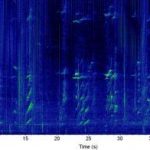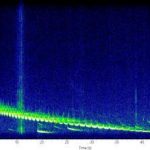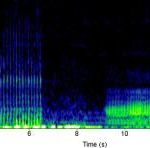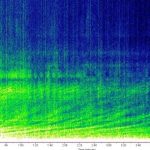Sound is essential to marine mammals for communication, orientation, navigation, prey detection and alertness – but they need to be able to hear! In recent decades, anthropogenic (man-made) noise has increased in the oceans, especially in the Northern areas due to increased shipping and oil and gas exploration. The opening of, until now, remote areas of the Arctic, means sound interference in areas that were previously protected by their inaccessibility.
Underwater Sound
The ocean is mostly dark, as light only penetrates a few hundred feet, so seeing is of limited use. Sound waves travel in darkness and very far, and sound is the absolute major information channel of many marine organisms, especially marine mammals. Whales and dolphins for example use hearing for orientation and navigation. They use sounds, emitting and receiving them, to find prey, avoid predators, communicate with each other for maintaining family and social bonds. One essential advantage of sound is that animals are able to hear from all around them, no matter where their attention is focused. But in order to be able to use sounds to communicate and orientate, be alerted and find food (echolocation), marine mammals need to be able to hear the returning sounds.
Oceans are filled with sounds. They can be natural, like those from wave activity and marine life such as marine mammals, fish, some invertebrates. They can be generated by human activities (anthropogenic). Sound is generally classified as continuous, i.e., low in intensity but more constant, such as from shipping (motor and sonar) and industrial activities, or impulsive, which is shorter in duration but high in intensity, such as from explosions, pile-driving, seismic exploration, and military sonar activity.
Listen to marine mammal sounds (© NEFSC-NOAA) and listen here to other kinds of marine sounds, from whales, to seals, fish, shrimps and vessels.
- Humpback-whale
- Killer whale
- Bearded seal
- Haddock
- Vessel
Anthropogenic Noise Impacts
In just the last 100 years, human activities have increased along coasts, further offshore, and in deep ocean environments. The resulting increases and changes in ocean noise levels can have major and even fatal impacts on marine life. Collectively they raise the background noise, creating a continuous background rumble and cacophony which may obscures animal hearing and reduces the ability of animals to communicate, avoid predators, find food and navigate.
Impulsive noise/acute sources, such as pile-driving activities, underwater detonations or low- and mid-frequency active sonar can cause disturbance and may create temporary or permanent reduced hearing or hearing loss. It may occur suddenly or develop gradually over time. At high exposure levels, impulsive noise can create physical injury and even death.
Low frequency, active (both transmitting and listening) sonars used by the military (LFA sonar) to detect submarines has the potential to kill, deafen and/or disorient whales, dolphins and all marine life, as well as humans. It is the loudest sound ever put into the world’s oceans. Military sonar activities have been linked to the mass stranding of some deep diving cetaceans all over the world. Necropsies have revealed internal injuries such as haemorrhages and tissue damage in ears, brain and lungs, as well as symptoms of decompression sickness.
Noise Management
There is insufficient information to understand the full extent of the problem. But marine sound interference is today recognised as a serious threat to marine mammals, notably cetaceans, with a pressing call for taking a precautionary approach in regulation.
Our use of the ocean will only continue to increase. It is not possible to remove all anthropogenic noise from the ocean, but it is possible to reduce some noise levels, and activities can be organised so they don’t happen in places and at times that are particularly sensitive for marine mammals.








